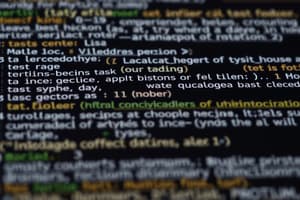Podcast
Questions and Answers
टेक्स्ट एनालिसिस का मुख्य उद्देश्य क्या है?
टेक्स्ट एनालिसिस का मुख्य उद्देश्य क्या है?
- डेटा की संरचना बदलना
- वर्ड काउंट को बढ़ाना
- डाटा में आकस्मिकता बनाना
- पैटर्न और थीम को समझना (correct)
सेंटिमेंट एनालिसिस केवल सकारात्मक भावनाओं की पहचान के लिए उपयोग किया जाता है।
सेंटिमेंट एनालिसिस केवल सकारात्मक भावनाओं की पहचान के लिए उपयोग किया जाता है।
False (B)
टॉपिक मॉडलिंग की प्रक्रिया का उपयोग किस लिए किया जाता है?
टॉपिक मॉडलिंग की प्रक्रिया का उपयोग किस लिए किया जाता है?
पाठों के संग्रह में सार्थक विषयों की पहचान करना
_________ टेक्स्ट में महत्वपूर्ण संस्थाओं को पहचानता और वर्गीकृत करता है।
_________ टेक्स्ट में महत्वपूर्ण संस्थाओं को पहचानता और वर्गीकृत करता है।
निम्नलिखित टेक्स्ट एनालिसिस प्रकारों को उनके विवरण के साथ मिलाएं:
निम्नलिखित टेक्स्ट एनालिसिस प्रकारों को उनके विवरण के साथ मिलाएं:
Flashcards are hidden until you start studying
Study Notes
Text Analysis
-
Definition: The process of examining and interpreting the content of textual data to extract meaningful information and insights.
-
Purpose:
- Understand patterns and themes within text.
- Identify sentiment, intent, and context.
- Assist in decision-making and data-driven strategies.
-
Types of Text Analysis:
-
Descriptive Analysis:
- Summarizes the content.
- Provides basic statistics (word count, frequency of terms).
-
Sentiment Analysis:
- Determines emotional tone (positive, negative, neutral).
- Useful in marketing, customer feedback, and social media monitoring.
-
Topic Modeling:
- Identifies abstract topics within a collection of texts.
- Common algorithms: Latent Dirichlet Allocation (LDA), Non-negative Matrix Factorization (NMF).
-
Named Entity Recognition (NER):
- Identifies and classifies key entities (people, organizations, locations) in the text.
-
Text Classification:
- Categorizes text into predefined labels or classes (spam detection, sentiment categorization).
-
-
Techniques Used:
- Natural Language Processing (NLP).
- Machine Learning algorithms for predictive analysis.
- Regular expressions for pattern matching.
- Statistical methods for data interpretation.
-
Applications:
- Market analysis and consumer insights.
- Social media monitoring and brand reputation management.
- Academic research to analyze large volumes of literature.
- Document classification and organization in information retrieval.
-
Challenges:
- Ambiguity in language (sarcasm, idioms).
- Variability in text formats and structures.
- Need for domain expertise to interpret results accurately.
-
Tools and Software:
- Python libraries: NLTK, spaCy, TextBlob.
- R packages: tm, quanteda.
- Commercial tools: SAS Text Analytics, IBM Watson Natural Language Understanding.
पाठ विश्लेषण
- परिभाषा: पाठ सामग्री की जानकारी और अंतर्दृष्टि निकालने के लिए पाठ डेटा का विश्लेषण और व्याख्या करने की प्रक्रिया।
- उद्देश्य:
- पाठ के भीतर पैटर्न और विषयों को समझना।
- भावनात्मक स्थिति, इरादा, और संदर्भ की पहचान।
- निर्णय-निर्माण और डेटा-आधारित रणनीतियों में सहायता करना।
पाठ विश्लेषण के प्रकार
-
वर्णनात्मक विश्लेषण:
- सामग्री का सारांश प्रदान करना।
- शब्द संख्या, शब्दों की आवृत्ति जैसी आधारभूत सांख्यिकीय जानकारी।
-
भावना विश्लेषण:
- भावनात्मक स्वर का निर्धारण (सकारात्मक, नकारात्मक, तटस्थ)।
- विपणन, ग्राहक फीडबैक, और सोशल मीडिया निगरानी में उपयोगी।
-
विषय मॉडलिंग:
- पाठों के संग्रह में सार्थक विषयों की पहचान।
- सामान्य एल्गोरिदम: Latent Dirichlet Allocation (LDA), Non-negative Matrix Factorization (NMF)।
-
नामित इकाई पहचान (NER):
- पाठ में प्रमुख इकाइयों (व्यक्ति, संगठन, स्थान) की पहचान और वर्गीकरण।
-
पाठ वर्गीकरण:
- पूर्व निर्धारित लेबल या श्रेणियों में पाठ को वर्गीकृत करना (जैसे, स्पैम पहचान, भावनात्मक वर्गीकरण)।
उपयोग की गई तकनीकें
- प्राकृतिक भाषा प्रसंस्करण (NLP)।
- भविष्यवाणी विश्लेषण के लिए मशीन लर्निंग एल्गोरिदम।
- पैटर्न मिलान के लिए नियमित अभिव्यक्तियाँ।
- डेटा व्याख्या के लिए सांख्यिकीय विधियाँ।
अनुप्रयोग
- बाजार विश्लेषण और उपभोक्ता अंतर्दृष्टि।
- सोशल मीडिया निगरानी और ब्रांड की प्रतिष्ठा प्रबंधन।
- शैक्षणिक अनुसंधान में बड़े साहित्य के आंकड़ों का विश्लेषण।
- सूचना पुनर्प्राप्ति में दस्तावेज़ों का वर्गीकरण और संगठन।
चुनौतियाँ
- भाषा में द्विविधता (व्यंग्य, मुहावरे)।
- पाठ प्रारूप और संरचनाओं में विविधता।
- परिणामों की सटीक व्याख्या के लिए विषय विशेषज्ञता की आवश्यकता।
उपकरण और सॉफ़्टवेयर
- Python पुस्तकालय: NLTK, spaCy, TextBlob।
- R पैकेज: tm, quanteda।
- वाणिज्यिक उपकरण: SAS Text Analytics, IBM Watson Natural Language Understanding।
Studying That Suits You
Use AI to generate personalized quizzes and flashcards to suit your learning preferences.




